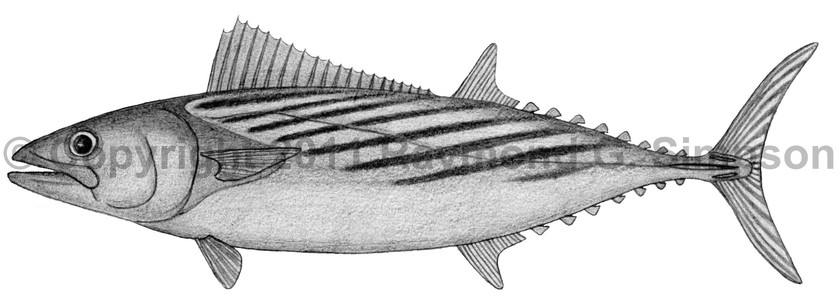
Common Name
Atlantic Bonito
Year Described
Bloch, 1793
Identification
Dorsal Fin: XX-XXIII, 13-18, followed by 7-9 finlets
Anal Fin: 14-17, followed by 6-8 finlets
Pectoral Fin: 22-27
Gill Rakers: 16-22 (on first arch)
Vertebrae: 50-55
Body fusiform, elongate, and relatively compressed in cross-section. Eye small (more than twice in snout length). Adipose eyelid absent. Jaw extends to rear of orbit. Teeth small and conical. Tongue without ridges. Two interpelvic processes; shorter than pelvic fins. Dorsal fins separated by a very small gap. Spiny dorsal fin long, with an almost straight rear margin. Second dorsal and anal fin small with tall anterior lobes. Pectoral fin short. Caudal fin semilunate. Corselet well developed; does not extend past pectoral fin tip. Body with tiny scales, except for the corselet where the scales are enlarged. Lateral line wavy. Two small caudal keels with a larger median keel in between them.
Color
Body bright silvery below and steel blue to blue-green above. The dorsal midline is almost black. A series (5-10) of oblique black bars on the dorsal half of the body posterior to the corselet. The fins are dusky to dark blue.
Size
Maximum size to 85cm FL. Commonly to 50cm FL.
Habitat
Pelagic in nearshore waters. Forms large schools.
Range
New England to S. Florida, and the Gulf of Mexico. Rare in the Caribbean Sea with scattered records along the continental coasts of C. and S. America. Also S. Brazil to Argentina.
References
Collette, B.B. 2002. Scombridae (pp 1836-1857). In: Carpenter. 2002. The living marine resources of the Western Central Atlantic. Vol. 3: Bony fishes part 2 (Opistognathidae to Molidae), sea turtles and sea mammals. FAO Species Identification Guides for Fisheries Purposes. American Society of Ichthyologists and Herpetologists Special Publication No. 5.
Froese, R. and D. Pauly. Editors. 2011.FishBase. World Wide Web electronic publication. www.fishbase.org
McEachran, J.D. and J.D. Fechhelm. 2005. Fishes of the Gulf of Mexico. Volume 2: Scorpaeniformes to Tetraodontiformes. University of Texas Press, Austin. i-viii +1-1004.